I have two stored procedures. First SP runs when records are received from server to save it in relationship table. Second SP runs after every fixed interval of time through a scheduler from .NET server.
First Stored Procedure Code:
BEGIN TRY
INSERT INTO RELATIONSHIP SELECT DATA FROM ANOTHER TABLE
SELECT INTO TEMPTABLE FROM RELATIONSHIP
UPDATE RELATIONSHIP SET...
END TRY
Second Stored Procedure Code:
BEGIN TRY
BEGIN TRANSACTION
SELECT INTO TEMPTABLE FROM RELATIONSHIP
UPDATE RELATIONSHIP SET ISPROCESSED = 1 WHERE ...
COMMIT TRANSACTION
END TRY
When the second stored procedure runs, it runs into a deadlock. Also, The first stored procedure is not written within a transaction.
What would be the best practice here to resolve the deadlock considering the code logic and flow cannot be changed? I have written code related to relationship table only and skipped code related to other table, as deadlock is occurring on this table. Let me know if you need more information, I can post the deadlock logs too from health monitor.
<deadlock>
<victim-list>
<victimProcess id="process207c2cd3c28" />
</victim-list>
<process-list>
<process id="process207c2cd3c28" taskpriority="0" logused="0" waitresource="PAGE: 5:1:53898 " waittime="774" ownerId="10078305" transactionname="UPDATE" lasttranstarted="2021-07-27T15:43:22.120" XDES="0x20d350857d0" lockMode="U" schedulerid="10" kpid="9288" status="suspended" spid="74" sbid="0" ecid="16" priority="0" trancount="0" lastbatchstarted="2021-07-27T15:43:21.030" lastbatchcompleted="2021-07-27T15:43:21.030" lastattention="1900-01-01T00:00:00.030" clientapp=".Net SqlClient Data Provider" hostname="" hostpid="6900" isolationlevel="read committed (2)" xactid="10078305" currentdb="5" currentdbname="" lockTimeout="4294967295" clientoption1="673185824" clientoption2="128056">
<executionStack>
<frame procname="ProcessMessage" line="153" stmtstart="11462" stmtend="11928" sqlhandle="0x03000500abb08931c097be0072ad000001000000000000000000000000000000000000000000000000000000">
UPDATE lar
SET
-- some code
FROM Relationship lar INNER JOIN --few joins </frame>
<frame procname="" line="133" stmtstart="10056" stmtend="10112" sqlhandle="0x03000500caf178474f6b59006ead000001000000000000000000000000000000000000000000000000000000">
</frame>
</executionStack>
<inputbuf>
Proc [Database Id = 5 Object Id = 1199108554] </inputbuf>
</process>
<process id="process20958d27848" taskpriority="0" logused="2060" waitresource="PAGE: 5:1:53794 " waittime="523" ownerId="9400887" transactionname="ProcessDiscrepancies" lasttranstarted="2021-07-27T13:24:45.573" XDES="0x20d2cb80420" lockMode="IU" schedulerid="2" kpid="7576" status="suspended" spid="94" sbid="0" ecid="0" priority="0" trancount="2" lastbatchstarted="2021-07-27T13:24:45.570" lastbatchcompleted="2021-07-27T13:24:45.573" lastattention="1900-01-01T00:00:00.573" clientapp=".Net SqlClient Data Provider" hostname="" hostpid="6900" loginname="" isolationlevel="read committed (2)" xactid="9400887" currentdb="5" currentdbname="" lockTimeout="4294967295" clientoption1="673185824" clientoption2="128056">
<executionStack>
<frame procname="ProcessDiscrepancies" line="140" stmtstart="10254" stmtend="11002" sqlhandle="0x030005003968a12f1d68be0072ad000001000000000000000000000000000000000000000000000000000000">
UPDATE lar
SET
IsProcessed = 1,
FROM Relationship lar
INNER JOIN --few joins </frame>
<frame procname="adhoc" line="1" stmtend="60" sqlhandle="0x010005007715562a80688d2c0d02000000000000000000000000000000000000000000000000000000000000">
EXEC ProcessDiscrepancie </frame>
</executionStack>
<inputbuf>
EXEC ProcessDiscrepancies </inputbuf>
</process>
</process-list>
<resource-list>
<pagelock fileid="1" pageid="53898" dbid="5" subresource="FULL" objectname="Relationship" id="lock1ffa075f280" mode="IU" associatedObjectId="72057597189357568">
<owner-list>
<owner id="process20958d27848" mode="IU" />
</owner-list>
<waiter-list>
<waiter id="process207c2cd3c28" mode="U" requestType="wait" />
</waiter-list>
</pagelock>
<pagelock fileid="1" pageid="53794" dbid="5" subresource="FULL" objectname="Relationship" id="lock204c8f59680" mode="U" associatedObjectId="72057597189357568">
<owner-list>
<owner id="process207c2cd3c28" mode="U" />
</owner-list>
<waiter-list>
<waiter id="process20958d27848" mode="IU" requestType="wait" />
</waiter-list>
</pagelock>
</resource-list>
</deadlock>

